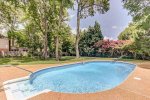I'm posting this topic in the Agree to Disagree area because I know all the TFP veterans hate trichlor. I have followed the TFP process of liquid bleach but I can't turn completely away from the convenience of my trichlor feeder. This certainly would only apply to pool owners living somewhere with very cheap water for CYA purposes. I'm just doing the math to compare the cost per ppm of free chlorine using the trichlor pucks compared to liquid bleach at 10% and the cost per FC is about half the cost with trichlor. I'm using PoolMath to get my number below.
Cost of only FC: I can get a 40 lb bucket of trichlor from Costco for $70 and PoolMath says I can get 4.2 FC per lb so this comes to $0.42 per ppm of FC. Buying chlorinating liquid 10% from Home Depot comes to be $2.99 per gallon if I purchase 12 gallons at a time. PoolMath says I get 3.8 FC per gal which comes to be $0.79 per ppm FC, which is roughly double.
CYA math: PoolMath says 1 lb of trichlor yields 2.6 of CYA. I estimate I need 10-12 ppm FC of chlorine per week based on current usage of bleach so over 5 months time, this would mean I would increase my CYA by 150 for the season. Since water in Memphis is so cheap, it would cost be about $60-70 to drain half my water to cut CYA in half. Doing a half drain twice per year to control CYA would cost me about $130 for water.
End cost comparison: If I used exclusively bleach, this would add at least $100-150 of cost for inconvenience due to having to purchase quantities of 12 gallons at a time making multiple trips per season to HD, add bleach daily with specific measurements, and store 10-15 gallons of bleach in a air conditioned closet in my house with two young kids.
Anyway, if I use only trichlor, it will cost me approx. $100 + 130 (water) = $230 per season. Using exclusively bleach 10%, it will cost me approx $200 + 125 (inconvenience) = $325 per season. Taking out negative opinions about trichlor, does anyone see any holes in my math? I'm not saying I will abandon bleach for exclusively using trichlor and I still plan to use a combo of 2 gallons of bleach and 2-3 trichlor pucks per week. I'm just trying to do the math on the best combo strategy because I like the convenience of only having to add a gal of bleach twice per week without measuring vs. daily dosage and I don't like having 10-15 gallons of bleach on hand.
Feel free to pick this apart since I'm a pool novice but I'm an analytical person who likes to figure out strategies on my own.
Cost of only FC: I can get a 40 lb bucket of trichlor from Costco for $70 and PoolMath says I can get 4.2 FC per lb so this comes to $0.42 per ppm of FC. Buying chlorinating liquid 10% from Home Depot comes to be $2.99 per gallon if I purchase 12 gallons at a time. PoolMath says I get 3.8 FC per gal which comes to be $0.79 per ppm FC, which is roughly double.
CYA math: PoolMath says 1 lb of trichlor yields 2.6 of CYA. I estimate I need 10-12 ppm FC of chlorine per week based on current usage of bleach so over 5 months time, this would mean I would increase my CYA by 150 for the season. Since water in Memphis is so cheap, it would cost be about $60-70 to drain half my water to cut CYA in half. Doing a half drain twice per year to control CYA would cost me about $130 for water.
End cost comparison: If I used exclusively bleach, this would add at least $100-150 of cost for inconvenience due to having to purchase quantities of 12 gallons at a time making multiple trips per season to HD, add bleach daily with specific measurements, and store 10-15 gallons of bleach in a air conditioned closet in my house with two young kids.
Anyway, if I use only trichlor, it will cost me approx. $100 + 130 (water) = $230 per season. Using exclusively bleach 10%, it will cost me approx $200 + 125 (inconvenience) = $325 per season. Taking out negative opinions about trichlor, does anyone see any holes in my math? I'm not saying I will abandon bleach for exclusively using trichlor and I still plan to use a combo of 2 gallons of bleach and 2-3 trichlor pucks per week. I'm just trying to do the math on the best combo strategy because I like the convenience of only having to add a gal of bleach twice per week without measuring vs. daily dosage and I don't like having 10-15 gallons of bleach on hand.
Feel free to pick this apart since I'm a pool novice but I'm an analytical person who likes to figure out strategies on my own.



